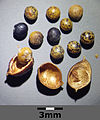Silk cheekbones
| Silk cheekbones | ||||||||||||
|---|---|---|---|---|---|---|---|---|---|---|---|---|

Silky cheekbones ( Dorycnium pentaphyllum subsp. Germanicum ) |
||||||||||||
| Systematics | ||||||||||||
|
||||||||||||
| Scientific name | ||||||||||||
| Dorycnium pentaphyllum subsp. germanicum | ||||||||||||
| ( Gremli ) chamois |
The silk cheek clover ( Dorycnium pentaphyllum subsp. Germanicum , syn .: Dorycnium germanicum ), other common names are silk hair cheek clover and German cheek clover , is a subspecies of the plant species Dorycnium pentaphyllum in the subfamily of the butterfly family (Faboideae) or a the butterflies.
description
The silk-cheek clover grows as a perennial herbaceous plant and reaches heights of 10 to 30 cm. The stems are prostrate to ascending. The alternately arranged leaves are sitting. The leaf blade is five-part. The leaflets are narrow-lanceolate, 5 to 15 mm long and 2 to 4 mm wide and are closely haired with short silky hair. The stipules are stunted and tiny.
The flowering period usually extends from July to August, sometimes from June to October. 6 to 14 flowers are grouped together in a head-shaped inflorescence . The hermaphroditic flowers are zygomorphic , up to 7 mm long and have little or no scent. The calyx is hairy and silky. The five white to pink petals are at a corolla with the typical form of the Pea family together. The tip of the shuttle is usually black-violet. The wing has a bulge ("cheek"), from which the genus Backenklee got its common German name . The legume is 2 to 4 mm wide and smooth.
The number of chromosomes is 2n = 14 or 28.
Occurrence and endangerment
The silk-cheek clover occurs in Europe from France via Switzerland , Italy , Austria to southeast Europe and to Poland and the Ukraine .
Dorycnium germanicum is indigenous in Germany along the Loisach and Isar as well as in various places in Bavaria
In Austria the cheeky clover occurs in the federal states of Burgenland , Vienna , Lower Austria , Upper Austria , Styria , Carinthia , Salzburg (uncertain), Tyrol and Vorarlberg in the colline to montane altitude range on (semi) dry grass and in pine forests . In Central Europe it is a character species of the Erico-Pinetum but also occurs in the Pulsatillo-Caricetum humilis from the Xerobromion association. It occurs frequently in the Pannonian region , otherwise rarely. It is endangered in the Rhine Valley and in the northern and southeastern Alpine foothills.
Taxonomy
It was first described in 1889 under the name ( Basionym ) Dorycnium jordanii var. Germanicum Gremli in August Gremli : Exkursionsflora für die Schweiz , 6th edition, p. 496. It was published in 1923 under the name Dorycnium pentaphyllum subsp. germanicum (Gremli) chamois as a subspecies of Dorycnium pentaphyllum Scop. in Gustav Hegi : Ill. Fl. Mitt.-Eur. , 4 (3), p. 1380. In some more recent floriculture works this taxon is listed as the species Dorycnium germanicum (Gremli) Rouy .
photos
swell
- Entry at GRIN.
- Entry at Tropicos
- Manfred A. Fischer, Karl Oswald, Wolfgang Adler: Excursion flora for Austria, Liechtenstein and South Tyrol . 3rd, improved edition. State of Upper Austria, Biology Center of the Upper Austrian State Museums, Linz 2008, ISBN 978-3-85474-187-9 .
- Datasheet for the silk cheek-clover at Botanik in the picture - Flora of Austria
Individual evidence
- ↑ a b Erich Oberdorfer : Plant-sociological excursion flora for Germany and neighboring areas . 8th edition. Verlag Eugen Ulmer, Stuttgart 2001, ISBN 3-8001-3131-5 . Page 600.
- ^ Dorycnium germanicum (Gremli) Rikli, German Backenklee. Botanical Information Node Bavaria, profiles on the vascular plants of Bavaria
Web links
- Silk cheekbones. In: FloraWeb.de.
- Silk cheekbones . In: BiolFlor, the database of biological-ecological characteristics of the flora of Germany.
- Profile and distribution map for Bavaria . In: Botanical Information Hub of Bavaria .
- Dorycnium germanicum (Gremli) Rikli In: Info Flora , the national data and information center for Swiss flora . Retrieved November 18, 2015.
- Thomas Meyer: Data sheet with identification key and photos at Flora-de: Flora von Deutschland (old name of the website: Flowers in Swabia )




